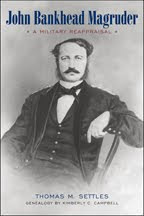

My writing assistants advise me that winter is coming. It’s chicken soup time, they say, pumpkin time, cozy all the time– except when it’s time for the walk!
This finds us still working on the next Marfa Mondays podcast. I’m almost finished transcribing a fascinating 4 hour interview recorded in the Cactus Capital of Texas, which I’ll be editing down to a listenable 45 minutes (or thereabouts). Stay tuned. Meanwhile, with the peculiarities of the past in mind, herewith, a book review from the archive:
Thomas M. Settles’
John Bankhead Magruder:
A Military Reappraisal
Originally published on this blog and my Maximilian-Carlota Research Blog
(sharing research on Mexico’s Second Empire / French Intervention),
February 15, 2011

As the subtitle indicates, most of Thomas M. Settles’ splendid biography of John Bankhead Magruder (1807 – 1871) is dedicated to a detailed examination of his role in the U.S. Civil War, specifically, his audacious if nonetheless inevitably doomed defense of Richmond, and later, Galveston. Though this part of the narrative does not have direct bearing on Mexican history, it informs the portrait of an unusually flamboyant Confederate who, in defeat, looked south to a future in Maximilian’s Mexican Empire.
Based on three decades of archival research, this biography must have been a titanic task, for Magruder left no diary and many of his most important papers were lost in a San Francisco fire. Worse, he was much maligned during his lifetime, victim of both malicious gossip from his Confederate rivals and less than sympathetic Federals– just the sort of thing to send a biographer down blind alleys. In addition, there were misunderstandings, as when earlier historians, in recounting what appeared to be a less-than honorable leave-taking from Washington DC at the start of the Civil War, confounded Magruder with a relative.
General John Bankhead Magruder was, as Settles convincingly argues– backing every point with what sometimes seems a forest of footnotes– a Civil War general whose tactical ingenuity and tenacity are deserving of far greater respect than he has been accorded. Most of the book details his early military career, from West Point to a garrison duty and recruiting at various army posts from the Carolinas to Maine, until, with the invasion of Mexico in the late 1840s, his fortuntes took a radical turn. Along with many of the men who would later play major roles in the U.S. Civil War– Grant, Lee, and McClellan, among them– Magruder distinguished himself in several major battles against the Mexicans. (Magruder’s artillery was, in fact, the first to fire upon Chapultepec Castle.) Following the U.S.-Mexican War, Magruder served in California, where in Los Angeles, briefly, he ran a saloon.
He was on a visit to Europe when recalled to Washington DC in 1861, only a month before his native state of Virginia seceded. He had not wanted to leave the U.S. Army, but as “he could not fight against his own people,” he resigned, calling it “the most unhappy moment of my life.” He walked across the Potomac, offered his services to the Confederacy and, in short order, was reporting to Robert E. Lee.
Settle’s treatment of Magruder’s return to Mexico in 1865, in the final chapter, “Postwar Odyssey,” is a relatively brief one; nonetheless, it is an important contribution to understanding the nature and role of the ex-Confederates in Maximilian’s government.
At the end of the U.S. Civil War, General Magruder was one of several thousand ex-Confederates who pulled up stakes for Mexico. In 1865 the French Imperial Army, considered the greatest in the world, occupied most, if not all of Mexican territory, while the ex Archduke of Austria, Maximilian, a direct descendant of the King of Spain during the Conquest, reigned as Emperor. Though by the late summer and fall of 1865, when the ex-Confederates began arriving en masse, the French occupation was beginning to fray at the edges, Maximilian and his consort, Carlota, still presided over a court and elaborate palace balls and other festivities that were, to Americans at that time, considered the height of glamor. In the words of journalist William V. Wells, this was the “high noon” of the empire, when it was impossible for many to even imagine the catastrophe that would, in only a matter of months, befall the “cactus throne.”
Some ex-Confederates came to Mexico because they could not bear living in a defeated South, others, because they had expected to participate in a dynamic plantation economy under the French-backed Maximilian (who, to entice the ex-Confederate colonists, proclaimed slavery legal in Mexico). But others, such as General Magruder, simply felt pushed out. As Settles writes:
“It must have been extremely difficult for so proud a man as John Bankhead Magruder to have signed the articles surrendering the Trans-Mississippi Department. But when the Federals began arresting and imprisoning high Confederate officials, he resolutely refused to submit to such personal humiliation. He was not eligible for the amnesty proclaimed by President Lincoln on December 8, 1863, or that proclaimed by Andrew Johnson on May 29, 1865”
Although I had spent several years researching Mexico’s Second Empire under Maximilian for my novel, The Last Prince of the Mexican Empire, until recently, I was flummoxed as to the background of the author of the exceedingly rare English language memoir, Sketches of the Last Year of the Empire, Henry R. Magruder. It turns out he was the son of General John Bankhead Magruder and I now know, from Settles’ biography, that father and son did not arrive in Mexico via the same route. General Magruder came down overland from Houston with General Shelby, while his wife, son Henry, and unmarried daughter, Kate Elizabeth, arrived via Veracruz, for they had come from Florence, Italy, where they had been residing for some years.
As Settles explains:
“[B]ecause of the hardships of travel, uncomfortable living conditions, and extremes of climate found in the remote locales where magruder was stationed during his military career, [Mrs Magruder] found it more practical to live and raise her children in the comforts of Baltimore, where she could stay closer to family business interests. She remained there until 1850 when, as a consequence of [daughter] Isabella’s ill health, she took her children to Europe. Mrs Magruder had relatives in Germany, but she moved to Italy, living briefly in Rome, then in Florence.”
From Texas, not yet reunited with his family, Magruder headed straight down to Monterrey and then to Mexico City, arriving in the summer of 1865.
Writes Settles:
“Magruder checked into a room on the first floor of the fashionable Iturbide Hotel, and there he received several distinguished visitors, including Matthew Fontaine Maury and his old friend Marshal Francois-Achille Bazaine, now in command of the imperial forces in Mexico. He also met with the British minister to Mexico, Sir Peter Campbell Scarlett, whose nephew, Lord Abinger, had married Magruder’s niece, Helen Magruder, in Montreal several years earlier.”
It appeared Magruder felt as at home as an American could be in Mexico City. He bought himself a new wardrobe, “‘a cut-a-way suit of salt and pepper color, with a tall dove-colored hat and patent leather boots,’ and then went to the palace of Montezuma [the Imperial Palace], which Scott’s army had victoriously occupied eighteen years earlier.”
Soon after a successful interview with Maximilian and Carlota, Magruder, now a naturalized Mexican citizen, was appointed head of Maximilian’s Land Office of Colonization. The idea was to establish colonies along the main route inland from Veracruz to Mexico City, on land Juarez (under the Republic) had expropriated from the Church.
Settles covers the rapid collapse of the scheme along with Maximilian’s government, and Magruder’s return to the U.S. In 1867– surprisingly, for memories of the Civil War remained fresh— he attempted to set up a law office in New York City. His family had returned to Italy, but he remained in the U.S. to work the lecture circuit with a crowd-pleasing talk on Maximilian and Carlota. He was on that tour when, in a Houston hotel in 1871 he died of a stroke.
In sum, this is an important addition to the bibliography on Confederates in Mexico, and crucial reading for anyone who studies the U.S. Civil War, the U.S.-Mexico War, and / or Mexico’s Second Empire. Highly recommended.

The Pecan: A History of America’s Native Nut By James McWilliams
A Review of Patrick Dearen’s
Bitter Waters: The Struggles of the Pecos River
